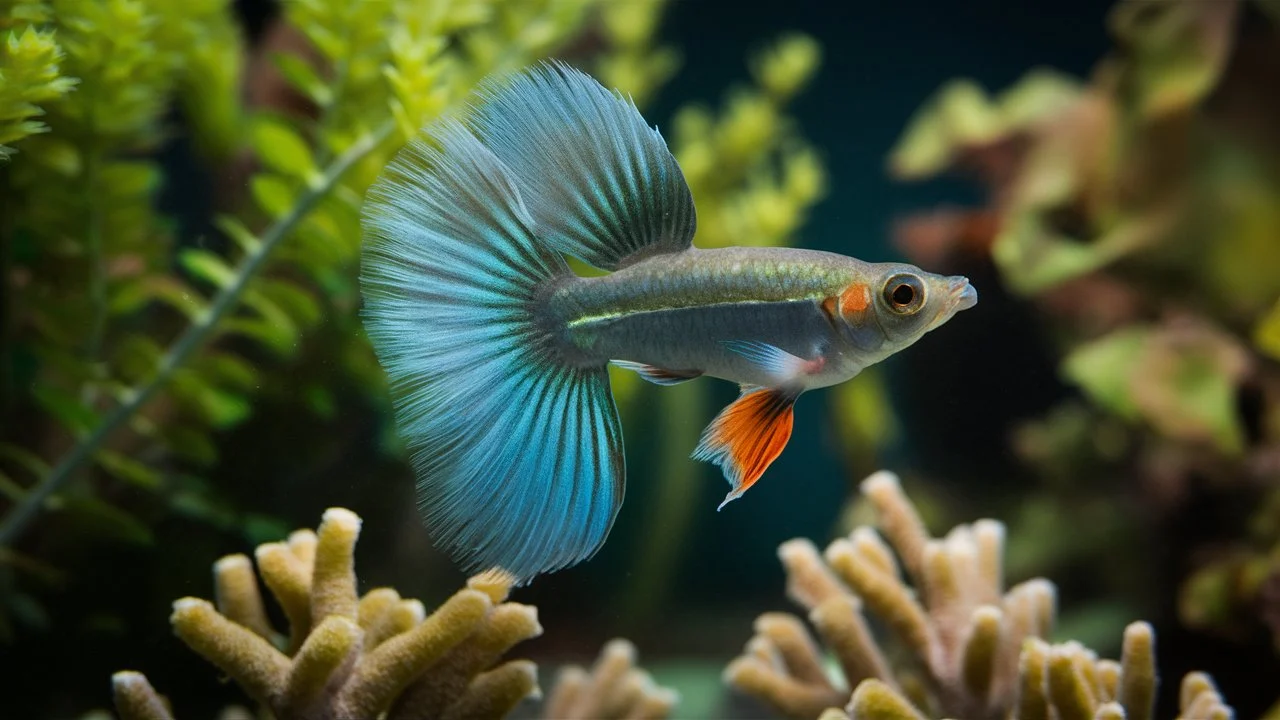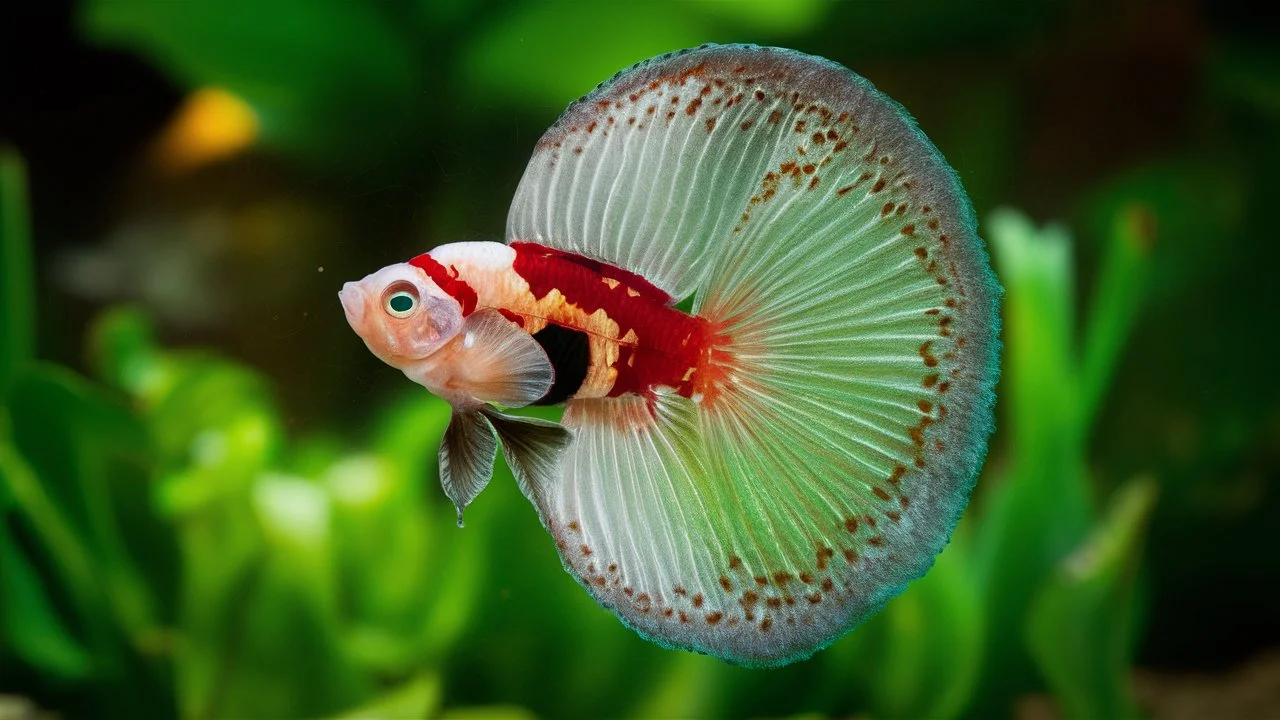The Elephant Ear Guppy is a small and colorful fish. Many people who love aquariums enjoy having them. The fish gets its name from its large, rounded fins that look like elephant ears. These fins, along with their bright colors and unique patterns, make them a beautiful addition to any aquarium.
Elephant Ear Guppies are easy to care for and are perfect for beginners. They are peaceful and get along well with other fish. These guppies are also very active and fun to watch as they swim around the tank. With the right care and a clean tank, they can live happily and stay healthy for a long time.
Elephant Ear Guppies usually cost between $2 to $10 each. They have a lifespan of 1 to 2 years with proper care. Breeding them is easy as they give birth to live babies, with females capable of having many at once. To keep these guppies healthy, ensure clean water, a balanced diet, and a stress-free environment. While they are generally hardy, they can fall ill if the tank is dirty or if they experience too much stress.
Table of Contents
ToggleHow Much Does an Elephant Ear Guppy Cost?
The price of an Elephant Ear Guppy typically ranges from $2 to $10 each. The cost can vary based on several factors, including the guppy’s color, pattern and fin size.

Factors Affecting the Price
- Color and Pattern: Guppies with more vibrant and unique color patterns tend to be more expensive.
- Fin Size and Shape: Larger and more distinct “elephant ear” fins can increase the price.
- Age and Size: Younger guppies or those that are already of breeding age might be priced differently.
- Health and Genetics: Guppies that come from a healthy lineage with desirable traits can cost more.
Additional Costs
When purchasing Elephant Ear Guppies, it’s also essential to consider the additional costs associated with setting up and maintaining a healthy environment for them. These costs may include:
- Aquarium Setup: Tank, filtration system, heater, and decorations.
- Food: High-quality fish food to keep them healthy.
- Maintenance Supplies: Water conditioners, test kits, and cleaning tools.
- Healthcare: Treatments for common fish diseases and regular check-ups.
By considering these factors, you can better understand the overall investment required to keep Elephant Ear Guppies in your aquarium.
Related reading: Pink Tuxedo Guppy Facts: Cost, Lifespan, Breeding, Health
How Long Does an Elephant Ear Guppy Fish Live?
The average lifespan of an Elephant Ear Guppy is between 1 to 2 years. With excellent care, some guppies can live slightly longer, reaching up to 3 years.
Factors Influencing Lifespan
- Water Quality
- Clean and well-maintained water is essential.
- Regular water changes and proper filtration can significantly extend their lifespan.
- Diet
- A balanced diet rich in nutrients helps keep guppies healthy.
- High-quality flake food, supplemented with occasional live or frozen foods, is ideal.
- Tank Environment
- A stress-free environment with plenty of hiding spots and plants can promote longevity.
- Avoid overcrowding the tank to reduce stress.
- Temperature
- Maintaining the water temperature between 72°F and 82°F (22°C to 28°C) is optimal for guppy health.
- Health Care
- Prompt treatment of diseases and regular health checks are vital.
- Being aware of common guppy illnesses and their symptoms can help in early detection and treatment.
By paying attention to these factors, you can help ensure your Elephant Ear Guppy lives a full and healthy life. Proper care and attention to their needs are key to maximizing their lifespan.
What Do Elephant Ear Guppies Eat?
Elephant Ear Guppies are not only known for their beautiful fins but also for their easy-to-manage diet. Providing a balanced diet is crucial for their health and vibrant colors.
Here is a detailed look at what Elephant Ear Guppies eat:
Basic Diet
- Flake Food
- High-quality flake food is the staple diet for guppies.
- Ensure the flakes are specifically formulated for tropical fish, providing essential nutrients.
- Pellets
- Pellets are another good option and can be used as a supplement to flakes.
- Choose small pellets suitable for guppies to ensure they can eat them easily.
Supplementary Foods
- Live Foods
- Guppies enjoy live foods like brine shrimp, daphnia, and bloodworms.
- Live foods are rich in protein and can enhance their color and vitality.
- Frozen Foods
- If live foods are not available, frozen alternatives are excellent.
- Frozen brine shrimp, bloodworms, and daphnia are readily accepted by guppies.
- Vegetables
- Guppies benefit from the occasional addition of vegetables to their diet.
- Blanched spinach, peas, and zucchini can be offered in small amounts.
Feeding Tips
- Feed Small Amounts
- Feed small amounts two to three times a day.
- Only give what they can eat within a few minutes to avoid overfeeding and water pollution.
- Variety
- Provide a variety of foods to ensure a balanced diet.
- Mixing flakes, pellets, live and frozen foods will keep them healthy and interested in their meals.
- Observe
- Watch your guppies during feeding to ensure all are eating well.
- Remove any uneaten food after a few minutes to maintain water quality.
By providing a varied and balanced diet, you can keep your Elephant Ear Guppies healthy, vibrant, and happy. Proper nutrition is key to their overall well-being and longevity.

Common Health Issues and Treatment of Elephant Ear Guppies
Elephant Ear Guppies are generally robust, but they can still face several health problems. Early detection and treatment are essential to keep them healthy. Here are some common health issues and their treatments:
1. Ich (White Spot Disease)
Symptoms:
- White spots appearing on the body and fins.
- The fish rubbing against objects in the tank.
- Rapid breathing and inactivity.
Treatment:
- Gradually increase the tank temperature to around 82°F (28°C).
- Add aquarium salt according to package directions.
- Use over-the-counter Ich treatments.
- Maintain high water quality with regular changes.
2. Fin Rot
Symptoms:
- Frayed or disintegrating fins.
- Dark or red edges on the fins.
- Decreased activity and poor appetite.
Treatment:
- Improve water quality with frequent water changes.
- Add aquarium salt to the water.
- Use antibacterial medication designed for fin rot.
- Avoid overcrowding the tank to reduce stress.
3. Swim Bladder Disease
Symptoms:
- Difficulty swimming normally.
- Floating at the top of the tank or resting at the bottom
- Loss of equilibrium.
Treatment:
- Fast the fish for 24 to 48 hours.
- After fasting, feed them cooked, peeled peas to help clear their digestive system.
- Ensure clean water conditions to prevent further complications.
4. Fungal Infections
Symptoms:
- White, fluffy growths on the body or fins.
- Sluggish movement and loss of appetite.
Treatment:
- Quarantine the infected fish in a separate tank.
- Use antifungal medications available at pet stores.
- Keep the tank clean and maintain proper water conditions.
5. Parasites
Symptoms:
- Visible tiny worms or spots on the skin.
- Scratching against objects in the tank.
- Rapid breathing and lethargy.
Treatment:
- Administer antiparasitic medication as directed.
- Quarantine affected fish to prevent spreading the parasites.
- Regularly clean the tank and monitor water parameters.
Prevention Tips
- Maintain Clean Water:
- Perform regular water changes and ensure proper filtration.
- Regularly test water parameters to keep them within safe ranges.
- Provide a Balanced Diet:
- Feed a variety of high-quality foods to strengthen their immune system.
- Avoid overfeeding to minimize waste and keep the water clean.
- Quarantine New Fish:
- Isolate new fish for at least two weeks before adding them to the main tank.
- This helps prevent the introduction of diseases to your aquarium.
- Reduce Stress:
- Avoid overcrowding the tank.
- Provide plenty of hiding places and maintain a stable environment.
By following these guidelines and being attentive to your guppies’ needs, you can help prevent and manage common health issues, ensuring your Elephant Ear Guppies thrive in a healthy and stress-free environment.
Breeding Process of Elephant Ear Guppies
Breeding Elephant Ear Guppies is a rewarding and relatively simple process. Here’s a step-by-step guide to help you successfully breed these beautiful fish:
1. Selecting Breeding Pairs
- Healthy Fish: Choose healthy, vibrant guppies with no signs of disease.
- Age and Size: Select mature guppies that are at least three months old. Males are usually smaller and more colorful, while females are larger and have rounder bellies.
2. Preparing the Breeding Tank
- Tank Size: A 10-gallon tank is suitable for breeding.
- Water Conditions: Maintain the water temperature between 76°F and 80°F (24°C to 27°C). Ensure the water is clean with proper filtration.
- Hiding Spots: Add plants or breeding mops to provide hiding spots for the female and the fry (baby guppies).
3. Breeding Process
- Introducing Pairs: Place the selected male and female in the breeding tank. Males will chase the females and display their fins to attract them.
- Mating: The male fertilizes the eggs inside the female. This process can take a few days.
4. Pregnancy and Birth
- Gestation Period: The female guppy is pregnant for about 21 to 30 days.
- Signs of Pregnancy: Look for a dark gravid spot near the rear of the female’s abdomen, which indicates developing fry.
- Birth: When ready, the female will give birth to live fry. Each birthing session can produce 20 to 50 fry, sometimes more.
5. Caring for the Fry
- Separating the Fry: Remove the female after giving birth to prevent her from eating the fry.
- Feeding: Feed the fry high-quality, finely crushed flake food or specially formulated fry food. Provide small amounts several times a day.
- Growth and Development: Keep the water clean and maintain stable conditions to ensure healthy growth.
6. Raising the Fry
- Tank Maintenance: Perform regular water changes to keep the environment clean.
- Gradual Integration: As the fry grow, they can be gradually introduced to the main tank with adult guppies.
By following these steps, you can successfully breed Elephant Ear Guppies and enjoy watching their colorful offspring grow and thrive.
Conclusion
Elephant Ear Guppies are beautiful and unique fish that can bring a lot of joy to your aquarium. With the right care, these guppies can live a healthy and happy life for up to two years. They need a balanced diet, clean water, and a comfortable environment to thrive. Regular health checks and a proper diet will help prevent common diseases and keep them active. By following these simple tips, you can ensure your Elephant Ear Guppies stay healthy and vibrant, adding beauty to your home aquarium.

1 thought on “Elephant Ear Guppies cost: Lifespan, Diet and Health Tips”